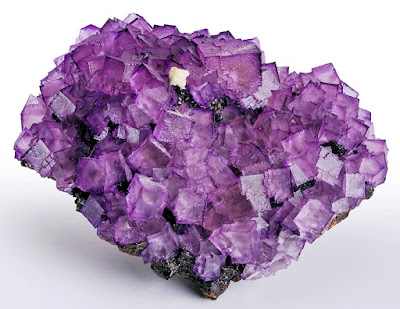What is the difference between minerals and crystals?
 |
| Gorgeous large cabinet plate of raspberry-purple Fluorite cubes clustered atop Sphalerite with Barite! From the Elmwood Mine, Smith County, Tennessee. credit:themineralgallery..com |
Have you ever wondered what the difference is between crystal and mineral? Perhaps you thought that there was none at all. Well, that is where you?re wrong. There are very significant differences between these two and knowing them would help you differentiate one from the other. Shall we get started, then?
A crystal is any solid that has an organized structure. That means that the atoms of this thing are positioned in very accurate distances and angles one from the other, as opposed to glass for example, in which atoms are in an more or less random arrangement.
Minerals are inorganic, naturally occuring substances that have crystalline structures. So it is a prerequisite to be a crystal in order to be a mineral. All minerals, therefore, form crystals.
On the other hand, there are crystals that are not minerals, because they are not naturally occuring, or because they are not inorganic. Sugar and proteins are examples of solids that form crystals but are organic, so are not minerals. Some syntethic substances used in nanotecnology are crystalline, but are man-made, so not considered minerals either.
Crystals and minerals differ, not only through the ways in which they are used but they also differ in terms of structure. To put it simply, a crystal is a structure made up of various natural materials whereas a mineral is a material in itself. Two or more minerals can actually have the same chemical composition and yet completely differ when it comes to crystal structure. These are known as polymorphs. Crystal structure can greatly influence the physical properties of a mineral. A good example of this would be diamonds and graphite. As you already know, diamonds are known to be the hardest of all minerals and yet, whilst it has the same composition as the graphite, the latter is very malleable in nature.
References: